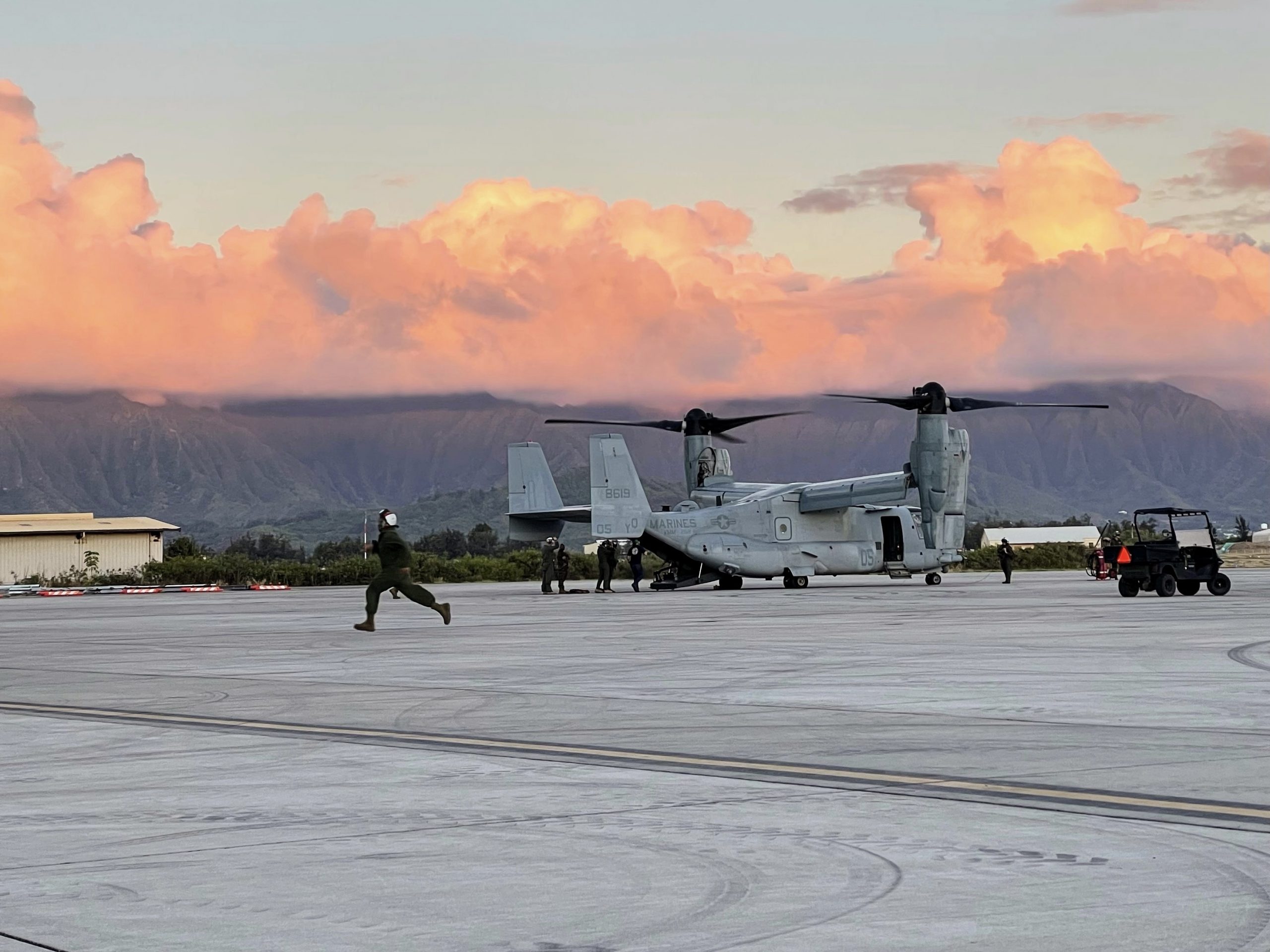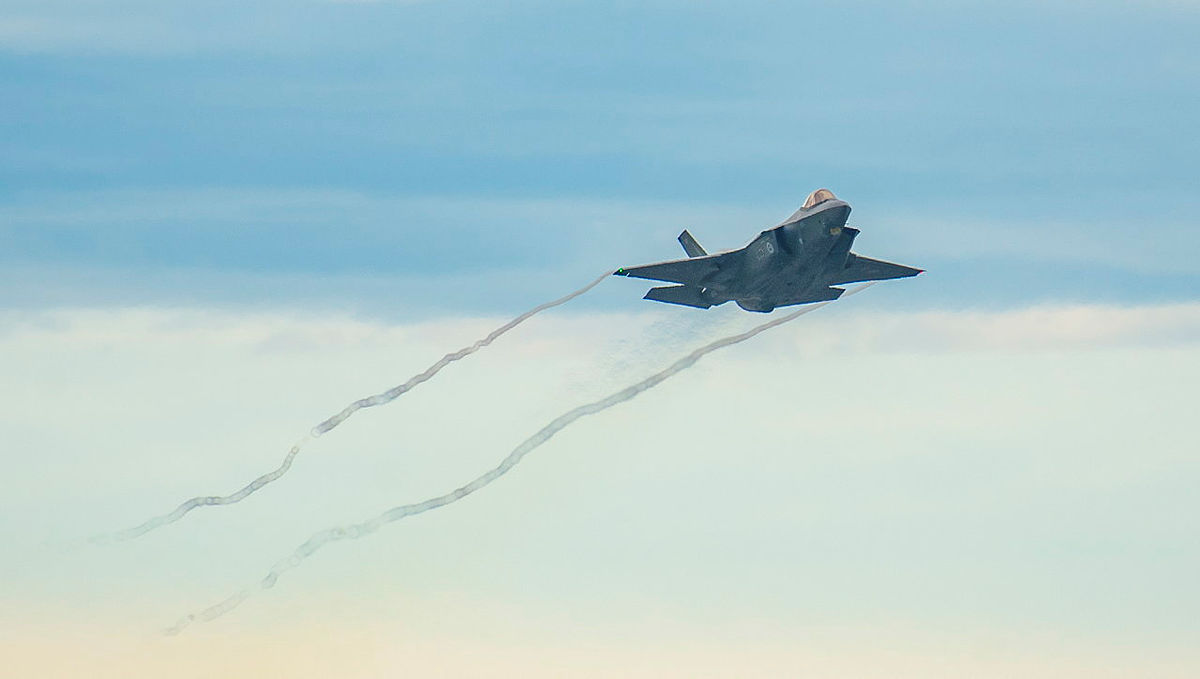By Robbin Laird
As the Marines rework how they work Pacific defense both with the joint and coalition forces, three key weapon systems enabling the effort are the F-35, the Osprey and C2 capabilities at the tactical edge.
Each of these systems brings different capabilities to the fight, but the underlying capabilities being underscored is an ability to operate from flexible bases, to be able to aggregate desired combat effects and to morph into flexible task forces at the point of interest.
I had a chance while visiting MARFORPAC during my August 2021 visit to discuss the way ahead with Marines involved with F-35s, Ospreys and C2 evolution in a single roundtable. The participants in the discussion from MARFORPAC were Col. Manlee Herrington, AC/S Aviation; LtCol Shane Bursae, Fixed Wing Air Officer; Maj. Paul DiMaggio, Rotary Wing Air Officer; and Maj James Arnold, Aviation C2 Officer.
As one participant put it: “We need to have the ability to close forces at the decisive point.
“We are operating as an expeditionary force which means we have to deploy agile and close rapidly.
“We need to combine speed with expeditionary flexibility and reach.
“That is why the F-35/Osprey combination is so critical for the Marines.”
In this article, I am leveraging the conversation and shaping a number of takeaways but am not holding the participants responsible in any way for those takeaways,
The F-35 Piece
The coming of the F-35 to the Pacific is a major difference from my earlier visit to MARFORPAC in 2014. The Marines operate two squadrons of F-35s from Iwakuni with a third rotational squadron to be added in the future. The Marines operate the most forward deployed F-35s in the region and operate from the first Island Chain.
Now the USAF has deployed the F-35 into the region, and the Marines are working closely with them in shaping what the USAF calls “agile combat employment,” something for which the F-35B is ideally suited.
The U.S. Navy is deploying F-35Cs into the Pacific with the introduction of the USS Carl Vinson carrier group. Marines are also involved as they are F-35C operators as well. Marine Fighter Attack Squadron (VMFA) 314 operates those aircraft.
With allies buying F-35s and working towards ship-based F-35B operations, the envelope of engagement of the Marines in shaping shared coalition operational concepts and capabilities has expanded as well. They are working with allied F-35As as well as F-35Bs which means that working the first island chain through to South Korea is clearly a work in progress.
Working closely with Japan and Australia as those allies deploy and develop their F-35 fleets provides significant opportunities to shape collaborative con-ops as well. Singapore is becoming an F-35 Security Cooperative Participant which extends the operational envelope as well for Marines working with allies in shaping collaborative defense capabilities and approaches.
The Marines as well are working new concepts like the Lightning Carrier, whereby operating of a ship like LHA-6, a larger number of F-35 can operate than with a traditional ARG-MEU. And intersecting the capabilities coming off the USS America with allies and the joint force afloat or based ashore provides an opportunity to expand significantly the impact of USMC F-35Bs can have in a combat situation in the Pacific. The reach of the sensor systems of an integratable F-35 fleet is a core enabler for the joint and coalition force in the Pacific.
But to get the full value out of a USMC F-35 force, it is crucial to fund the enablers.
The weapons development calendar is behind schedule, and there is a clear need to ramp up the weapons planned for development for the F-35 enterprise. As the U.S. shifts from the land wars, it is important to ramp up high-end capabilities in the missile domain for sure.
A second key enabler is tanking.
The KC-130J fleet is a key asset for USMC operations, and they are in short supply. If one wants to focus on their role to supply bases spread throughout the Pacific, then you are not highlighting their tanking role.
If you are highlighting the tanking role, then you are reducing the ability to supply bases. There is no way around this other than ramping up the buys of KC-130Js.
The Osprey Piece
When I was last at MARFORPAC in 2014, the Osprey was making its presence known. It was the key bedrock for shaping what was then possible with regard to the strategic approach for the distributed laydown.
In fact, I would argue that the Osprey was the bedrock for the initial transition of the Marines to a distributed laydown ecosystem which underlies the current approach to shape a more integrated distributed force.
We discussed at the outset during the meeting of the significant nature of the transition from the Ch-46 to the Osprey and the impact of that transition on the rest of the Marine Corps force. The shift away from a rotorcraft mindset has been a challenging one for the Marine Corps, and indeed one which the U.S. Army has yet to do. It is not just about speed and range; it is about rethinking how one operates in the extended battlespace.
And that thought process is still a work in progress.
When the Ospreys first came to the Pacific, an immediate impact was filling the gap caused by a shortage of KC-130Js. The Ospreys could move supplies and Marines around in ways that the KC-130J would traditionally do, with the role of the KC-130J in air refueling then highlighted.
Now as the Marines look to operate from multiple launch points and to do so with working from a network of sea and expeditionary bases, the role of the Osprey is without doubt enhanced.
At the same time, the ways an Osprey can support or work with such a force have expanded significantly.
One example has been highlighted in the recent Island Marauder 21 exercise which was held a week after my visit, but which we discussed during the roundtable.
This is how a recent article released by the USMC described the engagement of the Osprey in the exercise.
“For example, one exercise saw participants seize terrain to enable artillery units to gain fire superiority on a distant island chain. The Marines of VMM-268 transported 3rd Marines and their equipment in an MV-22 Osprey from a pickup zone to a nearby island. Marines traveled in an Osprey equipped with a Networking On-the-Move system for an airborne command and control exercise.
“Networking On-the-Move, a critical Force Design capability, was also integrated into a prototype Utility Task Vehicle and wheeled onto another MV-22 aircraft, showcasing its mobility and transportability. NOTM is a satellite command and control system Marines can leverage to communicate while mobile on the battlefield. “This was the first time 3rd Marines have used NOTM on an aircraft,” said Maj. Ben Gardner, MCSC’s lead for Island Marauder 2021. “The task proved successful.”
“During Island Marauder, MCSC integrated their communication equipment with LINK-16, a standardized communications system used by the U.S. and allied militaries. These capabilities helped to test interoperability among the joint forces in a denied or degraded environment.”
What the participants underscored was the importance of working new capabilities for the Osprey and the F-35 to work together, to shape various payloads, which the tandem could deliver to a distributed integrated force.
For example, the East Coast Marines have recently worked a distributed G/ATOR system deployed on an expeditionary base in support of the fleet.
How might this be worked in the Pacific?
Can the G/ATOR radar be reconfigured to be delivered by a platform other than the KC-130J?
Could it be done by Ospreys and CH-53Ks for example, and provide for even greater basing flexibility?
How to configure Ospreys to deliver USVs into the battlespace with ISR systems for information or deception?
In other words, taking the concept innovations forward, how best to leverage what the revolutionary duo of F-35 and Osprey can deliver to the force?
The C2 Piece
C2 is a weapon system for shaping and synchronizing the delivery of fires and maneuver of an integrated distributed force.
One participant drew an analogy between the USMC transition from CH-46 to the Osprey in terms of what was going on with C2. He argued that with the focus on the land wars, we are just beginning to see the implementation of a generational leap forward with the latest sensors and information systems.
But with a shift to working in contested environments, and one prioritizing expeditionary operations, new capabilities and new concepts of operations were necessary. Technology is at hand to shape a way ahead but ensuring that a distributed force can work in an integrated manner is an ongoing challenge.
What was described is that what historically was capabilities inherent in Marine Corps Aviation is now being pushed down to the expeditionary battalion level.
But as the Marines reshape themselves for operating as an inside force, how to ensure that the C2 for the inside force integrates with the air combat element for the Marines, or the Naval strike force or PACAF’s agile employment force?
As one participant put it: “This is uncharted territory.”
And with regard to the deployment of the new Marine Littoral Regiment, how to ensure that it has the appropriate reachback capability to ensure mission success?
In short, as one works the USMC transition, the Marines already have in their hands a number of the key tools for the transition.
It is just important to realize and remember that going forward.
Featured Photo: Marines prepare to launch a Networking-on-the-Move Airborne-equipped MV-22 Osprey at Marine Corps Base Hawaii, Aug. 12, 2021. Marines with 1st Battalion, 3rd Marines participated in a notional air assault as part of Island Marauder. NOTM-Airborne provides Marines with real-time command, control and collaborative mission planning while airborne. (U.S. Marine Corps photo by Ashley Calingo)







